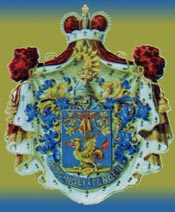
Conflicts with the Ottoman Empire
Although Samegrelo was not a part of the original Islamic Caliphate established by the Arabs in the seventh century, it came under the domination of the Caliphate’s successor, the Ottoman Turkish Empire, in the 16th century. This domination lasted until the early 19th century, when Samegrelo submitted to the authority of the Russian Empire. While the Ottomans allowed the rulers of Odishi (as Samegrelo was known before the 19th century) to exercise a high degree of autonomy for much of this time, the threat of active subjugation was always present.
As early as 1453, when Constantinople fell to the armies of Sultan Mehmed II, the Ottoman Empire posed a clear threat to Odishi. Until this point, Odishi had no great need to maintain naval forces or to concern itself with attack by sea; now it faced an expanding empire in the Black Sea region that possessed the most powerful navy of the day. The looming threat was realized in 1634, when Sultan Murad IV decided to punish Odishi for its efforts to cultivate ties with the Ottomans’ rival to the west, Persia. Sixty boats of Ottoman troops landed on Codori Cape, destroyed Drandi monastery, and ravaged the adjacent area. Unfamiliar with amphibious tactics, the forces of Odishi were utterly unable to resist the crushing assault.
For more than two centuries following this incident, Ottoman and Odishian military forces came to blows on several occasions. In the summer of 1703, the Turks simultaneously invaded Imereti, Guria, and Odishi. However, the Sultan was forced to recall his troops because of a rebellion in Istanbul, and the Georgians decimated his retreating army. Shortly afterward, Odishian forces under George IV Dadiani captured the strategically important Ottoman-held fortresses at Rukhi and Anaklia for a brief time; but the Turks soon recaptured them.
An anti-Turk rebellion erupted in Odishi in 1722, and for a time, Ottoman rulers were concerned that the forces of Bejan I Dadiani would conquer the Empire’s fortresses in the Principality. Once again, however, the Turks’ dominance of the Black Sea proved decisive; Istanbul sent a naval squadron to support its forces, and the fortresses held.
By the middle of the 18th century, the growing power of Russia to the north was altering the military equation in the region. Rulers in both eastern and western Georgia sought to align themselves with Christian Russia against the Islamic Ottoman and Persian Empires that had long borne down on the Georgians in their isolated Christian enclave. Throughout the 18th and 19th centuries, the militaries of the Russian and Ottoman Empires clashed repeatedly, and their conflicts sometimes spilled over into Odishi.
The tide was clearly turning against the Ottomans by the time the Russo-Turkish War of 1768-1774 erupted. In this conflict, Russian forces engaged Ottoman armies ensconced in Imereti, Guria, and Odishi. A unified army of Imeretian and Russian soldiers drove the Ottomans from Imereti, forcing them to assume a defensive position at Poti Castle on the Black Sea coast of Odishi. The Odishian forces of Katsia II Dadiani also entered the battle on Russia’s side, and succeeded in taking the fortresses at Rukhi and Anaklia.
Samegrelo—as Odishi became known after becoming a Russian protectorate in 1803— was also involved when war broke out between Russia and Turkey in 1806. In 1808, Russian and Mingrelian[1] troops marched on the Turks’ position at Poti and succeeded in dislodging the Ottoman defenders, but were compelled to return the outpost to Turkey under the terms of the 1812 Treaty of Bucharest that ended the war. However, in the next Russo-Turkish War (1828-1829), the Ottomans were once again driven from Poti, and their defeat in this war was so resounding that the Ottoman Empire was forced to recognize Russia’s sovereignty over Georgia as part of the peace settlement.
Samegrelo was also drawn into the Crimean War (1854-56), in which Russia faced an alliance that included the Ottoman Empire, France, and the United Kingdom. In this conflict, the forces of Odishi under the interim ruler Ekaterine Chavchavadze-Dadiani—widow of the deceased ruler, David Dadiani, and mother of his underaged successor, Niko Dadiani—were at first forced to engage the invading Turks without Russian support, as Russia’s forces were tied down on other fronts. The Mingrelians put up a dogged defense, resorting to guerilla tactics, and eventually were able to repulse the Turkish offensive when assistance from Russia arrived later in the conflict. Although Russia and Turkey were to clash several more times before the final collapse of Turkey’s imperial ambitions in the years following World War I, this was the last time their the ongoing rivalry directly touched Samegrelo.
[1] Although not all of Samegrelo’s people are members of the Mingrelian linguistic group (discussed in the Ethnography section below), the people of Samegrelo are traditionally referred to collectively as “Mingrelians” (or “Megrelians”), and the usual adjectival form is likewise “Mingrelian.”
[ TOP ]
